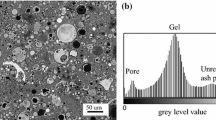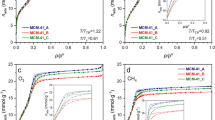Abstract
Argon(87 K) and nitrogen(77 K) adsorption of three types of porous samples (microporous, microporous-mesoporous and mesoporous) was evaluated. The shapes of isotherms, specific surface areas, mesopore-, micropore- and net pore volumes, pore-size distributions (PSD) and positions of micropore and mesopore PSD’s maxima were compared to ascertain the credibility of individual adsorbates for the texture information estimation. The shapes of adsorption isotherms for Ar and N2 of all samples are similar and the adsorbed amounts at relative pressure x = 0.975 differ slightly. For mesoporous samples some differences are observed between specific mesopore surface areas derived from nitrogen and argon isotherms. Radii of pore size maxima from Ar(87 K) PSD’s are on average systematically lower than from N2(77 K) for all samples. The Saito-Foley approach for ZSM-5 samples gives consistently lower mean pore radius from N2(77 K) adsorbate than from Ar(87 K). This difference probably arises from the multiplication factor, Ω, in the Saito-Foley equation which includes physical properties (magnetic susceptibility, polarizability etc. at 77 and 87 K) and is not easy to obtain with sufficient precision. The use of both adsorbates Ar(87 K) and N2(77 K) possesses some advantages as well some disadvantages and the comparison of textural properties of individual samples must be evaluated with respect to adsorbate.





Similar content being viewed by others
Abbreviations
- a:
-
Adsorbed amount
- am :
-
Monolayer capacity
- aμ :
-
Adsorbed amount in micropores
- C:
-
Constant in BET and modified BET equation
- p:
-
Adsorbate pressure
- p0 :
-
Saturated adsorbate vapor pressure at its normal boiling point
- Q:
-
Objective function
- R:
-
Pore radius
- rm :
-
Most frequent mesopore radius
- rμ :
-
Most frequent micropore radius
- Sm :
-
Mesopore surface area
- SBET :
-
Surface area from the classic BET equation
- V:
-
Pore volume
- Vp :
-
Net pore volume
- Vm :
-
Mesopore volume
- Vμ :
-
Micropore volume
- X:
-
Relative adsorbate pressure (x = p/p0)
References
S. Storck, H. Bretinger, W.F. Maier, Appl. Catal. A 174, 137 (1998)
A. Zukal, M. Thomes, J. Čejka, Micropor. Mesopor. Mater. 104, 52 (2007)
P. Kowalczyk, M. Jaroniec, A.P. Terzyk, K. Kaneko, D.D. Do, Langmuir 21, 1827 (2005)
A.V. Neimark, P.E. Ravikovitch, M. Grun, F. Schuth, K.K. Unger, J. Colloid Interf. Sci. 207, 159 (1998)
J.C. Groen, L.A.A. Peffer, J. Pérez-Ramírez, Micropor. Mesopor. Mater. 60, 1 (2003)
M. Kruk, M. Jaroniec, Micropor. Mesopor. Mater. 44–45, 725 (2001)
P. Prokešová-Fojtíková, S. Mintova, J. Čejka, N. Žilková, A. Zukal, Micropor. Mesopor. Mater. 92, 154 (2006)
J. Čejka, N. Žilková, J. Rathouský, A. Zukal, J. Jagiello, Langmuir 20, 7532 (2004)
L. Matejova, T. Cajthaml, Z. Matej, O. Benada, P. Kluson, O. Solcova, J. Supercrit Fluids 52, 215 (2010)
S. Brunauer, P.H. Emmett, E. Teller, J. Am. Chem. Soc. 60, 309 (1938)
P. Schneider, Appl. Catal. A 129, 157 (1995)
J.B. DeBoer, B.C. Lippens, B.G. Linsen, J.C.P. Broekhoff, A.V.D. Heuvel, Th.J. Osinga, J. Colloid Interf. Sci. 21, 405 (1966)
E.P. Barret, L.G. Joyner, P.B. Halenda, J. Am. Chem. Soc. 73, 373 (1951)
A. Saito, H.C. Foley, Microporous. Mater. 3, 531 (1995)
S. Ban, T.J.H. Vlugt, Mol. Simul. 35, 1105 (2010)
D.D. Do, H.D. Do, D. Nicholson, Chem. Eng. Sci. 65, 3331 (2010)
M. Kruk, M. Jaroniec, C.H. Ko, R. Ryoo, Chem. Mater. 12, 1961 (2000)
H. Luan, M. Hartmann, D.Y. Zhao, W.Z. Zhou, L. Kevan, Chem. Mater. 11, 1621 (1999)
J.A. Nelder, R. Mead, Comput. J. 7, 308 (1965)
W.H. Press, B.P. Flannery, S.A. Teukolsky, W.T. Vettering, Numerical Recipes (Cambridge University Press, Cambridge, 1986)
C.L. Yaws, Chemical Properties Handbook (McGraw-Hill, New York, 1999)
R.T. Jacobsen, S.G. Penoncello, E.W. Lemmon, Thermodynamic Properties of Cryogenic Fluids (Springer, Heidelburg, 1997)
International Critical Tables of Numerical Data, Physics, Chemistry and Technology, 1st electronic edn. ed by E.W. Washburn 1926–1930 (Knovel, 2003)
P.A. Webb, C. Orr, Analytical Methods in Fine Particle Technology. (Micromertics, 1997)
L. Matějová, O. Šolcová, P. Schneider, Micropor. Mesopor. Mater. 107, 227 (2008)
M. Jaroniec, M. Kruk, J.P. Olivier, Langmuir 15, 5410 (1999)
M. Kruk, M. Jaroniec, Chem. Mater. 12, 222 (2000)
B.F. Roberts, J. Colloid Interf. Sci. 23, 266 (1967)
ASAP 2020 Operator′s Manual V3.00 (Micromeritics, 2004)
Ch. Baerlocher, L.B. McCusker, D.H. Olson, D.H. Olson, Atlas of Zeolite Framework Types, 6th edn. (Elsevier, Amsterdam, 2007)
Acknowledgments
The financial support of the Academy of Sciences of the Czech Republic, Program Nanotechnology for Society (KAN400720701) and of the Grant Agency of the Czech Republic (104/09/0694 and 104/09/P290) is gratefully acknowledged.
Author information
Authors and Affiliations
Corresponding author
Appendix
Appendix
Saito-Foley [11] relation between micropore radius, r, and relative pressure, x, at which spontaneous condensation in micropores takes place, r(x):
\( \ln (x) = \frac{3}{4}{\frac{{\pi {\text{A}}}}{{{\text{R}}_{g} T}}}\,\,{\frac{\Upomega }{{{\text{d}}_{o}^{4} }}}\sum\limits_{k = 0}^{\infty } {\left[ {{\frac{1}{k + 1}}\left( {1 - {\frac{{{\text{d}}_{o} }}{r}}} \right)^{2k} \left\{ {\frac{21}{32}\alpha_{k} \left( {{\frac{{{\text{d}}_{o} }}{r}}} \right)^{10} - \beta_{k} \left( {{\frac{{{\text{d}}_{o} }}{r}}} \right)^{4} } \right\}} \right],} \)where the interaction parameter, Ω, is defined as:
The coefficients α k and β k are given by recurrent relations:
Here, N denotes the surface number of adsorbate gas molecules or porous sample atoms, d is the diameter of adsorbate gas molecule or adsorbate surface atom, mc2 stands for the kinetic energy of an electron (0.8183 × 10−6 erg), α is the polarizability of porous sample atom or adsorbate gas molecule and χ is the diamagnetic susceptability of porous sample atom or adsorbate gas molecule. The lower index S denotes the porous sample, A denotes the adsorbate surface atom.
The following values were used for calculations of interaction parameter, Ω:
Zeolites (index ‘S’) | Argon (index ‘A’) | Nitrogen (index ‘A’) | |
|---|---|---|---|
d (A) | 3.04 | 2.95 | 3.00 |
N (molecules/cm2) | 3.75 × 1015 | 7.608 × 1013 | 6.71 × 1013 |
−χ (cm3) | 1.94 × 10−29 | 3.22 × 10−29 | 3.6 × 10−29 |
α (cm3) | 0.85 × 10−24 | 1.63 × 10−24 | 1.76 × 10−24 |
Interaction parameters, Ω (erg.cm4):
Adsorbate | Adsorbent: zeolite |
|---|---|
Ar at 87 K | 3.19 × 1043 |
N2 at 77 K | 3.49 × 1043 |
Rights and permissions
About this article
Cite this article
Šolcová, O., Matějová, L., Topka, P. et al. Comparison of textural information from argon(87 K) and nitrogen(77 K) physisorption. J Porous Mater 18, 557–565 (2011). https://doi.org/10.1007/s10934-010-9409-x
Published:
Issue Date:
DOI: https://doi.org/10.1007/s10934-010-9409-x




